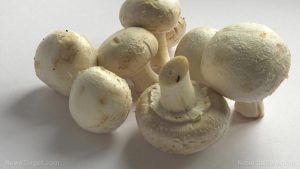Button Mushroom – sources, health benefits, nutrients, uses and constituents at NaturalPedia.com
06/07/2017 / By Earl Garcia

Button mushrooms are usually called common or commercial mushrooms, as these fungi can be found in virtually any grocery store. In fact, button mushrooms are the most consumed mushrooms across the U.S. According to the U.S. Department of Agriculture, button mushrooms account for 90 percent of mushroom intake in the country.
List of known nutrients
An article in MushroomInfo.com has listed the essential vitamins and minerals found in button mushrooms.
- Copper
- Niacin
- Pantothenic acid
- Potassium
- Riboflavin
- Selenium
- Vitamin A
- Vitamin C
- Vitamin D
- Zinc
Medicinal uses for button mushroom
Button mushrooms are an excellent source of copper that help the body generate a sufficient number of blood cells in order to maintain a healthy heart. Button mushrooms are also found to curb inflammation in arterial cells and inhibit white blood cells from sticking into arterial walls. They also prevent the formation of plaques in the arterial walls. In addition, button mushrooms reduce inflammation in the arteries. Furthermore, the fiber and enzyme content in button mushrooms burn harmful cholesterol in the body, and maintain a healthy balance of both good and bad cholesterol. The high potassium in button mushrooms also maintains healthy blood pressure levels. This makes the superfood beneficial in the treatment of disorders than stem from cholesterol imbalance such as stroke.
The superfood is also touted for its anti-cancer properties. Button mushrooms are rich in beta-glucans and linolieic acids that offer anti-carcinogenic effects. These compounds are also known to reduce tumor size and inhibit them from multiplying. This makes button mushroom an ideal food to prevent the onset of prostate cancer. Button mushrooms are also found to regulate the female hormone estrogen to normal levels, as well as reduce the performance of testosterone hormones, which lowers the risk of developing breast cancer. Button mushrooms are also touted to reduce the odds of suffering from colon cancer.
In addition, button mushrooms are an excellent natural source of insulin and certain enzymes that helps break down sugar, starch, and other complex carbohydrates. The high fiber content in button mushrooms also accelerate digestion and prolong satiety. This makes button mushrooms an essential food for diabetes and weight loss. Furthermore, button mushrooms are packed with calcium that ease joint pains and calcium decay in the bones. It also boosts bone health. Button mushrooms are also rich in iron that helps stave off anemia. It also contains natural antibiotic agents that inhibit the growth of microorganisms and fungus in the body.
Body systems supported by button mushroom
Button mushrooms are noted for their cholesterol-lowering effects that greatly benefit the heart. The circulatory system also benefits from button mushroom consumption as the superfood reduces the risk of anemia. Button mushrooms are also beneficial to the digestive system as it facilitates sugar, starch, and carbohydrate metabolism. In addition, button mushrooms are loaded with enzymes that promote satiety and induce weight loss. The nutrient-rich superfood is also essential in maintaining bone health. In addition, button mushrooms boosts the body’s overall health by preventing the onset of breast, prostate and colon cancer.
Ways to use button mushroom
Button mushrooms have long been valued for their flavor and nutrient content. They are most notably used in sautes, soups and other tasty recipes.
Where to learn more
- Common mushrooms, anti-inflammation medicine
- The Sexiest Thing That You Should Put Into Your Body
- Powdered mushrooms build immunity
- Mushrooms as good an antioxidant source as more colorful veggies (press release)
- Is your thyroid sluggish? Foods that benefit the thyroid with selenium and iodine
Summary
Button mushrooms prevent the onset of heart disease, anemia, cancer, and diabetes.
Button mushrooms are ideal for weight loss and bone health, and slashes the risk of fungal infection in the body.
Button mushrooms benefit the heart, the digestive system, and the bones.
Sources include:
Tagged Under: Button mushroom





















